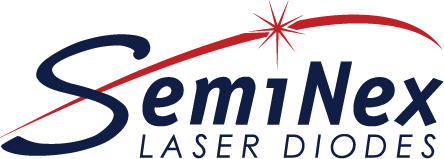Increases Power by More Than 50 Percent vs. Comparable Lasers on Market
Peabody, MA – Dec. 16th, 2020 – SemiNex announces its new Gallium Antimonide (GaSb) lasers in the 1900-2400nm range that provide 50% more power than comparable lasers on the market today. The new GaSb laser diodes achieve high power using a GaInAsSb/AlGaAsSb strained QW ridge waveguide technique grown by molecular beam epitaxy (MBE) on GaSb substrates. SemiNex’s 1940nm laser diode demonstrates high optical power of 1.5W and a low threshold current density of less than 100 A/cm2 at room temperature in continuous-wave (CW) conditions. GaSb laser diodes are prevalent in medical, material processing and gas sensing applications.
“The introduction of this new 1940nm laser diode will support our customers in the medical, material processing and gas sensing market with higher power diodes enabling smaller, more efficient, and more effective laser systems,” says Ed McIntyre, VP of Business Development at SemiNex.
Medical Applications
Lasers at a 1900-2400nm wavelength play a crucial role in advanced medical procedures such as varicose veins, tonsillectomies and brain surgery.
In a varicose vein procedure, the laser light is absorbed in tissue at a precise target depth to close the vein from the inside quickly without pain. This allows for a shorter operation time with limited scarring.
In a tonsillectomy procedure, laser diodes with a 1940nm wavelength cut through the tissue with reduced pain and increased efficacy when compared to other methods such as electrocautery. 1940nm lasers have twice the absorption coefficient of a 1470nm laser and 100 times that of a 980nm laser; this helps to prevent the mass pooling of blood in procedures such as neurosurgery. In a brain procedure, 1940nm lasers are capable of vaporizing and coagulating tissue, helping to prevent further blood loss and speed up the repair of damaged tissue.
In dentistry, GaSb lasers are used in place of radiographs to detect lesions on teeth which appear as pits and fissures, signs of early occlusal decay. This early find by the laser prevents the need for surgery.

1940nm lasers have twice the absorption of 1470nm and 100 times the absorption of lasers in the 800-1000 nm range.
Material Processing
Lasers produced in the 2µm range find use in industrial applications such as the welding of transparent plastics. GaSb laser welders allow the welding of these plastics by focusing 1940nm light that is absorbed strongly by C-H bonds in the polymer. Many transparent plastics share similarities; these plastics can be absorbed adequately by laser light in the 1940-2400nm range permitting direct processing with the lasers. When compared to lasers operating at 1µm, absorption can only be accomplished through additives to the material resulting in a more complex process. Additional applications for material processing in the 1940nm range include the processing and fabrication of bio-fluidic chips, used for biological and medical mass-screening experiments.
“Our GaSb laser didoes in the 1900-2400nm range support businesses in medical, material processing, and gas sensing fields. We are excited to enable our medical systems customers to develop higher power systems that improve recovery times and minimize swelling and scarring with higher performance laser components. We also look forward to improving the performance in plastic welding and gas sensing applications by enabling higher powers and efficiency while reducing the system size and cost,” says David Bean, CEO of SemiNex Corporation.
Gas Sensing
Lasers with a 1900-2400nm spectral range can detect atmospheric gases such as H2O, CO2 and N2O. Ammonia can be detected through the laser system by exploiting the specific absorption of the gas at a determined wavelength. Backscattered light at this wavelength is compared with the level of returned light at another wavelength to confirm the presence of the gas of interest while eliminating other potential contaminants.
SemiNex GaSb laser diodes at 1940nm are available for immediate delivery as bare chips and in TO9-can packages. Other packages at 1940nm are available upon request with reasonable lead times. Customer wavelengths from 1900-2400nm are available upon request. For more information contact SemiNex or your nearest SemiNex distributor.
